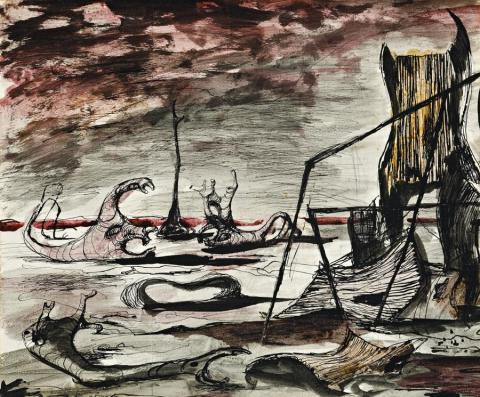STUDY FOR DROUGHT SERIES, 1945
Russell Drysdale
ink and wash on paper on composition board
37.0 x 44.5 cm
signed lower left: Russell Drysdale
Joseph Brown Gallery, Melbourne
Private collection, Melbourne
Klepac, L., The Life and Work of Russell Drysdale, Bay Books, Sydney, 1983, p. 83 (illus.)
Russell Drysdale's visit to the drought-stricken areas of New South Wales in late 1944 resulted in some of the most individual landscapes yet seen in Australian art. Described as the worst drought in our history, Drysdale responded to the devastation with a singularity of presentation and sense of drama that was gripping. To capture the surreal horror of the reality, Drysdale created works of nightmarish intensity that in turn became works of extraordinary beauty. The individuality of forms was set in colours of Venetian richness, of redness and theatrical splendour. For some, they were so unusual that they saw in them visions of another planet - of lunarscapes and the red planet.
Who can forget their first sighting of those 1945 paintings Walls of China in the Art Gallery of New South Wales or Desolation in the collection of the Castlemaine Art Gallery and Historical Museum, their ominous atmosphere and clawing trees like some fallen dinosaur of times beyond recall? Drysdale's journey among the fields of drought also gave birth to other masterly paintings of 1945, especially The Broken Mill and Crucifixion (Art Gallery of New South Wales) in which the agony of the Cross is related to the Holocaust, Hiroshima, and of the land. All is shrouded in a ghastly glow hot with passion. It is no accident that the shapes of some of the trees metamorphose into the human form, especially arms and their torn out veins and arteries, for in tragedy man and nature are one. As Lou Klepac has written, 'It is not only his gifts as a painter or his facility for drawing which have made Drysdale such a significant artist but the harmony which he has established with his environment.'1
The pen and ink drawing, Study for the Drought Series 1945, has links with all these paintings, the frozen contortions of the dead trees inspired by the British sculptor Henry Moore's inventive forms and harmonious voids. Nature and the man made are harmonised in their shared demise and echoing forms, heroic in their stillness of life. In mythological terms, it is the setting of an epic struggle where only mute monuments to the legendary heroes remain. The Bosch-like uprooted trees and twisted corrugated iron of the fallen building lead into another important drawing in this series, Study for Deserted Out-Station 1945. Both drawings possess that vitality which comes from first-hand experience. The latter drawing was squared up and translated into paint - Deserted Outstation 1945 in the collection of John Fairfax Holdings Limited, an outstanding work among masterpieces. These drawings and paintings are part of that compassionate and humanist vision that is unique to Russell Drysdale.
1. Klepac, L., 'Foreword', The Drawings of Russell Drysdale , Art Gallery of Western Australia, Perth, 1980, p. 8
DAVID THOMAS
